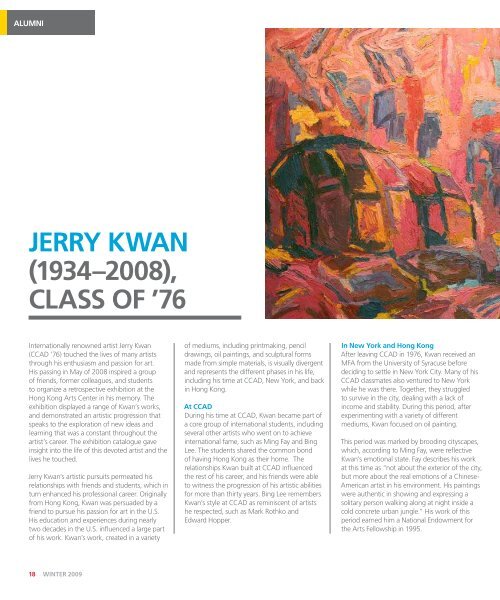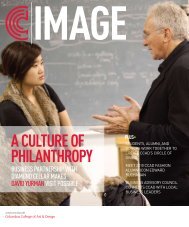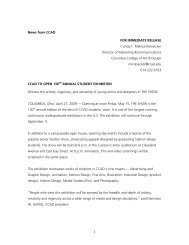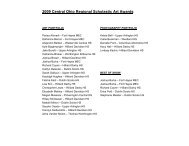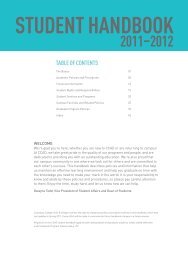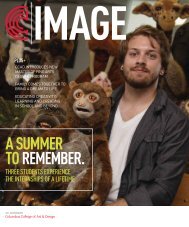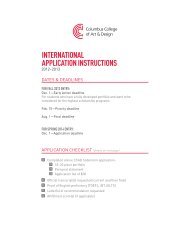ALUMNI. RE-ENGAGED. - Columbus College of Art and Design
ALUMNI. RE-ENGAGED. - Columbus College of Art and Design
ALUMNI. RE-ENGAGED. - Columbus College of Art and Design
Create successful ePaper yourself
Turn your PDF publications into a flip-book with our unique Google optimized e-Paper software.
EXHIbITS <strong>ALUMNI</strong><br />
JERRy kWAN<br />
(1934–2008),<br />
CLASS Of ’76 The Ro<strong>of</strong>top Houses, 1984<br />
Internationally renowned artist Jerry kwan<br />
(CCad ’76) touched the lives <strong>of</strong> many artists<br />
through his enthusiasm <strong>and</strong> passion for art.<br />
his passing in may <strong>of</strong> 2008 inspired a group<br />
<strong>of</strong> friends, former colleagues, <strong>and</strong> students<br />
to organize a retrospective exhibition at the<br />
hong kong arts Center in his memory. the<br />
exhibition displayed a range <strong>of</strong> kwan’s works,<br />
<strong>and</strong> demonstrated an artistic progression that<br />
speaks to the exploration <strong>of</strong> new ideas <strong>and</strong><br />
learning that was a constant throughout the<br />
artist’s career. the exhibition catalogue gave<br />
insight into the life <strong>of</strong> this devoted artist <strong>and</strong> the<br />
lives he touched.<br />
Jerry kwan’s artistic pursuits permeated his<br />
relationships with friends <strong>and</strong> students, which in<br />
turn enhanced his pr<strong>of</strong>essional career. originally<br />
from hong kong, kwan was persuaded by a<br />
friend to pursue his passion for art in the u.s.<br />
his education <strong>and</strong> experiences during nearly<br />
two decades in the u.s. influenced a large part<br />
<strong>of</strong> his work. kwan’s work, created in a variety<br />
18<br />
<strong>of</strong> mediums, including printmaking, pencil<br />
drawings, oil paintings, <strong>and</strong> sculptural forms<br />
made from simple materials, is visually divergent<br />
<strong>and</strong> represents the different phases in his life,<br />
including his time at CCad, new york, <strong>and</strong> back<br />
in hong kong.<br />
At CCAD<br />
during his time at CCad, kwan became part <strong>of</strong><br />
a core group <strong>of</strong> international students, including<br />
several other artists who went on to achieve<br />
international fame, such as ming fay <strong>and</strong> Bing<br />
lee. the students shared the common bond<br />
<strong>of</strong> having hong kong as their home. the<br />
relationships kwan built at CCad influenced<br />
the rest <strong>of</strong> his career, <strong>and</strong> his friends were able<br />
to witness the progression <strong>of</strong> his artistic abilities<br />
for more than thirty years. Bing lee remembers<br />
kwan’s style at CCad as reminiscent <strong>of</strong> artists<br />
he respected, such as mark rothko <strong>and</strong><br />
edward hopper.<br />
In New york <strong>and</strong> Hong kong<br />
after leaving CCad in 1976, kwan received an<br />
mfa from the university <strong>of</strong> syracuse before<br />
deciding to settle in new york City. many <strong>of</strong> his<br />
CCad classmates also ventured to new york<br />
while he was there. together, they struggled<br />
to survive in the city, dealing with a lack <strong>of</strong><br />
income <strong>and</strong> stability. during this period, after<br />
experimenting with a variety <strong>of</strong> different<br />
mediums, kwan focused on oil painting.<br />
this period was marked by brooding cityscapes,<br />
which, according to ming fay, were reflective<br />
kwan’s emotional state. fay describes his work<br />
at this time as “not about the exterior <strong>of</strong> the city,<br />
but more about the real emotions <strong>of</strong> a Chineseamerican<br />
artist in his environment. his paintings<br />
were authentic in showing <strong>and</strong> expressing a<br />
solitary person walking along at night inside a<br />
cold concrete urban jungle.” his work <strong>of</strong> this<br />
period earned him a national endowment for<br />
the arts fellowship in 1995.<br />
In 1997, kwan returned to hong kong, where he<br />
taught <strong>and</strong> became a mentor to many students. his<br />
homecoming marked another change in his art. once<br />
again he experimented with new materials—this time<br />
integrating parts <strong>of</strong> Chinese folk tradition. kwan used<br />
simple sculptural forms including paper cuts, wood, <strong>and</strong><br />
textile materials to re-create Chinese deities in a modern,<br />
“pop art” style. this stylistic change made reference to<br />
his homecoming while paying homage to his Chinese<br />
heritage.<br />
Bing lee remembers kwan this way: “I think Jerry has<br />
always been young at heart to me, always wanting<br />
to learn. I admired his courage—if he wanted to do<br />
something, he found a way to do it.”<br />
top rIght:<br />
Jerry kwan (kneeling, front) with fellow students at<br />
CCad, 1974<br />
Bottom rIght: In this article in Megachine magazine<br />
from the late 1990s, CCad alumnus patrick Chu (’75)<br />
spoke with kwan about the influence <strong>of</strong> Chinese<br />
philosophy in his work.<br />
WINTER 2009 IMAGE MAGAZINE<br />
19


